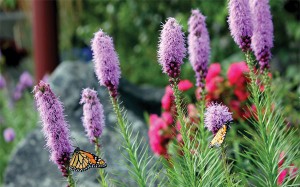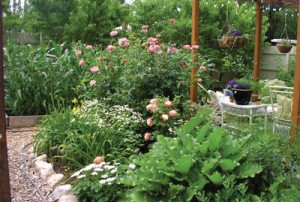Yardening 101
Posted on April 1, 2017 by Sarah Spencer
From front yard gardens to backyard mini meadows, yardening incorporates edibles and expands the traditional garden plot to encompass an entire yard’s landscape. It’s a great option for small, urban lots, but can work for any size yard.
Did You Say Yardening?
Yes, yardening!
“Yardening is the blissful marriage of a yard and a garden,” says Margaret Mary Gerhard, yardening pioneer, enthusiast and speaker.
Think yards blooming with native grasses, wildflowers, herbs and veggies; rain gardens, backyard prairies, raised garden beds and more.
“I started planting mugwort, oregano, and chives next to and amongst my lilies, anemones, heirloom peonies, and spiderwort,” says Gerhard, who eventually recycled her entire lawn when she realized it didn’t serve her the way fresh flowers, mint, and lemon balm did.
Steve Schultz, president of Outagamie County Master Gardener Association, says that yardening is representative of a country-wide back-to-nature trend, and isn’t just for the home; it’s for schools, communities and businesses too.
“Yardening is a way to add more variety to an outdoor space and learn about plant and food sources at the same time,” Schultz says. “People want to know where their food comes from. It’s neat to see kids who’ve only ever known perfectly-machine-shaped, store-bought carrots discover what a carrot really looks like.”
Yardening for Benefits
While the uniformity of a manicured lawn can be pleasing to the eye, a landscape mimicking the natural world can offer much more than just visual appeal.
Schultz says “exercise, exposure to fresh air, flexibility, strength in lifting, as well as a sense of inner peace and enjoyment,” are just a few of the benefits you’ll experience.
Yardening can also foster community connection.
“People often stop to ask me what type of plant this or that is,” Schultz says. “They’d never guess rhubarb or horseradish could have such big beautiful leaves. I’ve met a lot of people that way.”
Harvesting edibles, like dandelion, burdock and mullein, says Gerhard, can also save you big bucks.
“Weeds are tasty and nutritious, and often powerful, good medicine,” she says. “Most are actually herbs, and are pricey when sold in health food shops. One of my most welcome spring dishes is sautéed dandelion greens with herbs and garlic.”
The list of benefits goes on: working native grasses, wildflowers, shrubs, fruit-bearing trees and edibles into your native landscape diversifies your yard’s ecosystem; supports healthy soil; reduces flooding and stormwater runoff; provides privacy from neighbors; saves you time, money and labor; and creates an oasis for birds, bugs, and butterflies.
“There are lots of benefits for wildlife,” says Joy Perry, chair of the Speaker’s Bureau from the Wild Ones of the Fox Valley Area. “Birds, insects, pollinators all evolved on native plants. If more people create natural corridors for birds, we can give them more habitat and food sources when they migrate.”
Overcoming the Challenges
Though yardening offers up innumerable benefits, it takes work, says Schultz.
“Gardens aren’t always beautiful year-round. Maintenance is key. Annual plants like tomatoes will die, and you need to be diligent in picking up fruits and vegetables that have gone bad,” he says.
Perry agrees, but points out maintenance is less intensive than with a conventional lawn.
“Planting something that is struggling less with nature takes less work,” she says. “Prairies are native to our region; they’ve evolved and adapted to our conditions, so they have a built-in survival benefit.”
In addition, some neighbors may be concerned by yardening. Before you start, advises Schultz, talk to your neighbors about what you’re trying to accomplish and why. Avoid taking your garden up to your neighbor’s property line. “Most neighbors want to see at least some grass, such as small strip between the sidewalk, their yard and yours.”
Perhaps the biggest challenge yardeners face is the law. City codes often specify what plants are considered noxious weeds and how high grasses are allowed to grow in urban areas.
To learn what your city’s codes are, contact the Wild Ones, says Perry. “Send a message on our website’s contact page, and we’ll put you in touch with the right person.”
Start Small
Do I want to …
- simply add variety to my lawn?
- make it a neighborhood destination or personal art project?
- create a more natural, sustainable environment such as a prairie?
- harvest herbs and vegetables, make medicinals or have fresh flowers for my home?
Once you define your goals, advises Schultz, don’t dig up your whole yard right away.
“Instead try using planters, or pots, or raised beds,” he says.
Kim Diaz, event coordinator for the Green Bay Garden Blitz, says buying a garden box or volunteering during the weekend of the Blitz is a great way to introduce yourself to edible yardening too. The public can pre-order raised garden boxes on their website, and on May 5, 6 and 7 volunteers will install them if you live within a 10 mile radius of the Brown County UW-Extension hub.
“It’s a great way to learn how easy it is and the many reasons why growing your own food is so important,” Diaz says.
Upcoming Event
Yardening: Reusing and Recycling with Margaret Gerhard
April 13
Presented by Fox Valley Sierra Club, learn how to make your own yard art, save the earth and some money too. 7-8pm. Gordon Bubolz Nature Preserve, Appleton. 730-9515.
At Home













Leave a Comment